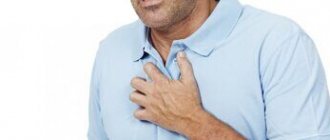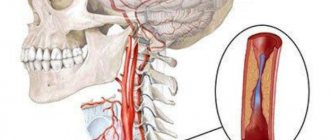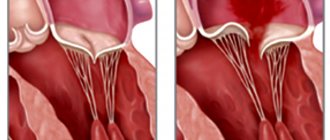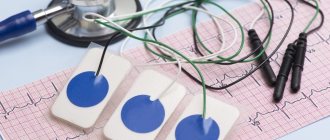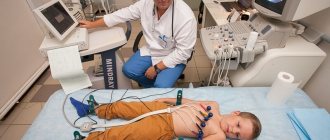© Author: Ilya Vitalievich Soldatenkov, general practitioner, especially for SosudInfo.ru (about the authors)
Parasystole is a special type of arrhythmia caused by the presence of an additional source of cardiac impulse generation , which functions independently of the main pacemaker. Parasystole is considered a combined pathology, in which an extraordinary cardiac contraction occurs as a result of an abnormal impulse coming from any part of the heart. A double rhythm occurs: the main one is set by the sinus node, and the additional one is set by other pathological sources of generation from any part of the conduction system.
The paracenter is a pathological pacemaker that can be located in the ventricles of the heart, atria, or atrioventricular junction. It can be combined and multiple. A person may not feel any extraordinary contractions. In some cases, they are perceived as interruptions in the functioning of the heart and discomfort in the chest.
Parasystole occurs in persons with pathology of the cardiovascular system, endocrinopathies, hematological diseases, dysfunction of the nervous system, as well as in athletes.
Parasystole is characterized by the simultaneous and independent appearance of several competing centers of automaticity. Pathology occurs more often in adults than in children. In children, parasystole is not combined with concomitant, severe myocardial lesions, which are associated with the appearance of pathology in adult patients. The disease is difficult to treat with antiarrhythmics. Drug treatment for parasystole should be long-term. In most patients, the pathology is persistent and persistently recurrent. Frequent parasystole, combined with organic or structural heart diseases, has an unfavorable prognosis.
About development mechanisms
The sinoatrial node, a bundle of muscle tissue in the heart in the wall of the right atrium, is responsible for the rhythm of normally functioning heart muscle.
The heart rate is not a constant value, but varies depending on the needs of the body: the signals that regulate the functioning of the sinus node come from the autonomic nervous system and from internal organs that release certain substances into the blood.
When the body experiences increased stress, the sinus node is instructed to produce more impulses per minute and it contracts at rest. In case of any disturbances, the sinus node can be normalized using a number of drugs to the effects of which it is extremely sensitive.
All of the above is a sign of the norm.
What is parasystole? This condition is caused by an additional source of electrical impulses in the heart muscle that works at its own pace rather than being controlled by brain signals or blood hormones and medications.
As a result, the heart muscle begins to contract under the influence of impulses emanating from either the sinus node or a competing node to correspond to the segment that first gave the signal. This phenomenon, known as double pacing, is accompanied by tachycardia (rapid heartbeat) or extrasystole (a type of arrhythmia).
If impulses from competing areas alternately reach the heart muscle, a person develops arrhythmias, which manifest themselves in the form of “stops”, “dizziness”, “jokes”, “jokes”, “metastases” of the heart.
Daily ECG monitoring showed that the patient's heart muscle produced more than 30,000 "unscheduled" contractions throughout the day.
Parasystole often goes unnoticed.
A patient with a double rhythm may be misdiagnosed as bigemia (every second beat is initiated by the parasystolic region) or trigemic (every third beat is “unscheduled”).
An incorrect diagnosis leads to equally erroneous treatment tactics: attempts to cure a patient of a non-existent extrasystole are ineffective, although they somewhat make the arrhythmia easier to bear.
What is the difference between parasystole and extrasystole?
- If additional unscheduled impulses come from one zone, the interval between the extrasystole and the normal contraction of the heart (the so-called feedback interval) may be the same time interval. This type of heart rhythm disturbance is characteristic of extrasystole.
- If the source of unscheduled impulses is two (or more) segments of the cardiac conduction system, the duration of the break in coherence will be variable and unstable. This image is typical for umbrellas.
However, both extrasystole and parasystole are variants of the same pathology: this explains the similarity of symptoms, causes, methods of therapy and prevention.
About the causes
The reasons contributing to the development of parasystoles can be both cardiac and extracardiac.
Cardiac causes may include the presence of:
- cardiac ischemia;
- cardiomyopathy (a disease that leads to changes in the structure and functioning of the heart muscle);
- myocarditis;
- heart failure;
- myocardial infarction (a disease that causes the death of a large number of contractile cells of the heart)
- Mitral valve prolapse (abnormal deviation of the mitral valve leaflets during ventricular contraction).
Parasystole caused by extracardiac factors can develop due to:
- hormonal abnormalities;
- high blood sugar;
- Diseases of the thyroid gland (hyperthyroidism and hypothyroidism, characterized by insufficient or excessive production of thyroid hormones);
- anemia;
- disorders of the autonomic nervous system;
- adrenal disease;
- changes in the composition of electrolytes in the blood;
- Overdose of certain medications (mainly those that stimulate the heartbeat).
Parasystole, the reasons for the sudden occurrence of which have not been identified, is called idiopathic.
Consequences
Parasystole is a dangerous condition that can negatively affect the activity of the heart. Pathology can provoke the following deviations:
- Ventricular fibrillation. An irregular and too rapid rhythm in this case even leads to the death of the patient.
- Heart failure. With a long course of the disease and the absence of adequate therapy, the ability of the heart muscle to contract is impaired.
Parasystole is a disease whose prognosis is favorable in most cases. Severe conditions develop only when the course is advanced or when there is untimely access to a medical institution. Compliance with all medical recommendations is the first step towards a full recovery. However, even after complete recovery, patients remain registered with a cardiologist.
Known forms
Depending on the location of the additional source of electrical impulses, umbrellas are divided into:
- ventricular (ventricular parasystoles are characterized by the fact that the competitive node is located in one of the chambers of the heart);
- Atria (the heart rate regulator is located in the atria);
- Compliant (the centers of extra impulses are located in different parts of the heart muscle); — Multiple (several competing nodes are located in one of the chambers);
- Multiple (several competing nodes are concentrated in one ventricle of the heart muscle);
- malaise emanating from the atrioventricular node.
Symptoms and signs
Parasystole can occur without any disturbing sensations and be detected by chance during an electrocardiographic examination prescribed for completely different reasons.
But the disease can manifest itself with a wide range of symptoms:
- attacks of tachycardia develop, accompanied by pre-syncope;
- the heart “tosses and turns”, “pushes”, “freezes”;
- performance decreases;
- fatigue increases;
- heart rate increases;
- worries about weakness;
- dizzy;
- my heart hurts.
Ventricular parasystole is distinguished by three main features:
- The presence of confluent complexes, the formation of which is based on impulses simultaneously emanating from the main pacemaker and the ectopic focus, exciting different parts of the heart muscle.
- Fluctuations in the intervals from the previous complex to the extrasystole are more than 0.1 sec.
- The law of “multiplicity”, which states that the shortest distance between parasystoles is related by a simple mathematical relationship with other, longer intervals of this kind.
The first and second signs can be detected on an ECG with a longer recording, but the third can only be detected with daily monitoring, with further careful decoding.
Features of symptoms
Parasystole can manifest itself:
- sudden heartbeat;
- sensations of turning over, pressure and temporary weakness of the heart muscle;
- impotence, fatigue, decreased performance, constant dizziness;
- mental pain accompanied by a feeling of fear;
- Preconscious states are accompanied by rapid heartbeat and cough.
The main electrocardiographic symptoms of parasystole are characterized by:
- the complete set of long intersection intervals;
- umbrella frequency from 25 to 65 beats per minute;
- violation of the regularity of sinus rhythm due to lack of connection with parasystoles;
- instability of the gap between the clutches;
- the presence of fluid ventricular complexes (with the coincidence of sinus and parasystolic syndromes).
In some patients, the disease has virtually no clinical manifestations. It was discovered accidentally during an ECG.
Case from practice
37-year-old patient S. was under outpatient observation for several years with a diagnosis of ventricular parasystole. The disease was difficult to tolerate, and treatment did not bring any visible effect. It was not possible to identify pathologies that could provoke parasystole.
S. was anxious and suspicious. She was asked to consult a psychotherapist and undergo endocardial EPS. The patient refused both. The ECG detected single and paired gastric parasystoles.
In a calm state, arrhythmia did not manifest itself. The patient was prescribed B-blockers, which were effective, but after stopping their use, the parasystoles returned.
An interesting situation was revealed after daily monitoring. While the woman was quietly driving in the car, sinus rhythm was observed. And then she gets into an accident, and parasystolic trigeminy immediately appeared, the heart rate rose to 150 with paroxysmal constant-recurrent ventricular tachycardia.
After the situation returned to normal, the rhythm changed to sinus tachycardia with single ectopic complexes, with various intervals before them.
After analyzing these data, the prescriptions were changed: the dose of B-blockers was reduced and Grandaxin, a daytime tranquilizer, was added. The effect was not long in coming. The patient was recommended to consult a psychotherapist and possible radiofrequency ablation.
Diagnostic methods
Diagnosis of parasystoles is carried out using the following methods:
- Collection and analysis of medical history. By interviewing the patient, the specialist collects information about the occurrence of complaints (when there was a feeling of rapid heartbeat, dizziness, loss of strength, heart pain and episodes of rapid heartbeat); analyzes family history (information about the presence of close relatives suffering from cardiovascular diseases) and the patient’s medical history (are there any chronic diseases, have any operations been performed, whether he has taken medications)
- Physical examination. The doctor checks the appearance and color of the skin, hair and nail plates, breathing rate, heart and lung murmurs.
- Laboratory tests. The patient's blood is taken for general and biochemical analysis, and a general urine test is performed.
- Determination of hormonal levels. Information about the amount of thyroid hormones makes it possible to exclude diseases of this organ that cause parasystolysis.
- Electrocardiography.
- Daily Holter ECG monitoring. Do an ECG within 1-3 days. In the case of parasystole, recording an ECG on this device makes it possible to determine its nature and the location of the source of additional impulses.
- Echocardiography, which allows you to detect pathological changes in the septa, valves and walls of the heart muscle.
- Treadmill or bicycle ergometry tests: tests performed using a special treadmill or exercise bike. When applying gradually increasing physical activity, the presence of cardiac ischemia is revealed, provoking parasystole. In this case, the nature of the parasystole changes with changes in load.
- Magnetic resonance imaging of the myocardium. To obtain volumetric images of the heart muscle, ventricular parasystole is indicated.
- An electrophysiological test that involves inserting a thin probe into the heart muscle (via the femoral vein). Thanks to this highly informative method, it is possible to accurately determine the nature of cardiac arrhythmias and the location of parasystoles.
Treatment options
Treatment of parasystoles can be carried out by pharmacological, non-therapeutic and surgical methods.
Non-drug therapy
- Quitting alcohol and smoking.
- Maintaining a proper sleep schedule.
- Reviewing the diet and including foods containing a large amount of dietary fiber (fruits, vegetables, herbs), avoiding fatty and spicy foods.
Drug therapy
This involves prescribing and taking medications:
- Metabolics (drugs that help improve metabolic processes);
- Beta blockers (drugs that reduce the strength and frequency of the heartbeat and suppress conduction in the heart);
- omega-3 fatty acids;
- antiarrhythmic drugs for the prevention of arrhythmias.
Surgery
Surgery for parasystole involves removing the source of additional impulses with radiofrequency current. The procedure is as follows: a thin tube (guidewire) is inserted through a vessel in the thigh into the heart muscle.
The conductor transmits a radiofrequency pulse, and the detected parasystole is removed.
